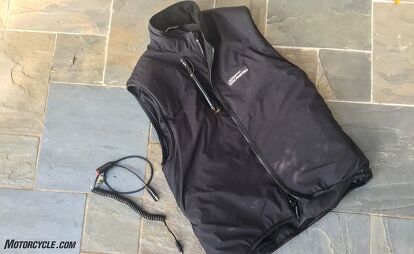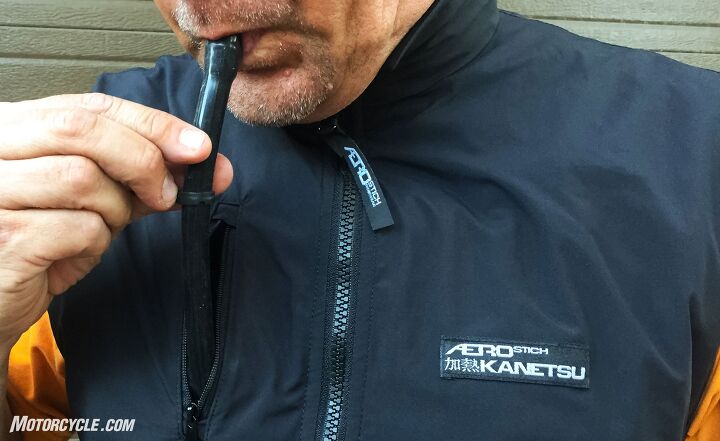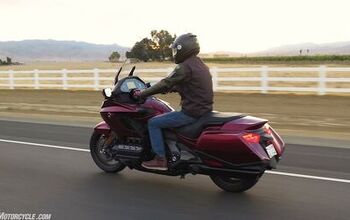MO Tested: Aerostich Kanetsu Airvantage Electric Vest Review

When was the last time you were hugged by your gear?
I bought my first electric vest in the winter of 1989, and I’ve been using them during cold weather ever since. When Tom Roderick and I began planning our SaddleSore 1000 ride, I knew that an electric vest would be essential piece of my ability to keep warm in the cold temperatures that were forecast during our riding through the night. Thinking that this would be the ideal time to test Aerostich’s newest electric vest, I ordered a Kanetsu Airvantage Electric Vest to see if its internal air bladder was a worthwhile innovation.
Aerostich Kanetsu Airvantage Electric Vest
| Aesthetics | 8.5/10 |
| Protection | 9.0/10 |
| Value | 8.0/10 |
| Comfort/Fit | 9.5/10 |
| Quality/Design | 9.0/10 |
| Weight | 9.0/10 |
| Options/Selection | 8.0/10 |
| Innovation | 9.5/10 |
| Weather Suitability | 9.5/10 |
| Desirable/Cool Factor | 9.0/10 |
| Overall Score | 89/100 |
Aerostich Kanetsu Electric Warmbib – Review
Ask MO Anything: Can I Make My Own Heated Clothing?
As with most electric gear, the Kanetsu Airvantage Electric Vest’s outer layer is windproof, in this case, constructed of Windstopper fabric to fend off cold drafts. To that, I added a pair of Windstopper zip-off sleeves ($77) for use with jackets that don’t provide enough weathertightness to keep drafts away from my arms. However, on my SaddleSore 1000, I was wearing a Spidi 4Season H2Out Suit that offered plenty of wind protection, so I didn’t need to wear the sleeves on the ride. The inner layer of the vest consists of the nylon liner that holds the heating element wiring. If we were considering the typical electric vest, some fiber-fill insulation or fleece would most likely be sandwiched between the windstopper and the nylon. However, the Airvantage takes a different approach.
As you can probably guess, the air in Airvantage refers to the use of air as an insulating layer. If you think about it, the fiber-fill and fleece also rely on air to assist in keeping the cold away from the rider. However, the Airvantage uses an air bladder to provide insulation, much in the way that a dry suit allows scuba divers to venture into waters that could kill unprotected humans in minutes. The air contained within the bladder surpasses that of the other insulating methods usually present in electric gear. Additionally, it serves a second function in this actively heated gear. By pressing the wire heating elements into more uniform contact with the rider, the air bladder allows for more efficient transfer of warmth to the rider’s torso. This self-equalizing pressure eliminates hot spots as a rider tries to maintain their core temperature, decreasing the heat setting required to stay warm – or, to put it another way, lowering the ambient temperature in which a person can comfortably ride.
Getting the right pressure in the Kanetsu Airvantage Electric Vest takes some trial and error. Make the pressure too high, and you’ll start to feel like the Michelin Man. Too low, and you won’t feel the optimal transfer of heat. Find the Goldilocks pressure, and you’ll feel like warm arms are wrapped around you.
On our SaddleSore 1000, the temperature dropped to 35 degrees, and thanks to the Kanetsu Airvantage, the only place I felt cold at that temperature was on the tips of my fingers – with medium-weight gloves! When I switched to heavier, winter gloves, I actually lowered the temperature on my vest with a thermostat similar to this one because I didn’t need to pump as much heat into my core to keep my fingers warm. (However, you can do it the old-fashioned way by just turning the vest on and off with the included switch.) During the chilliest portion of our ride, I only wore a base layer and a t-shirt under the Kanetsu which allowed the heat to easily transfer to my core.
The vest’s fit is comfortable, and the heating element in the collar is a nice addition. The cut of the vest (higher in the front and lower in the rear) is ideal for the seated position one has when riding. The interior of the vest has two functional pockets: One pocket allows for storage of the wiring harness, and the other, larger one lets you fold the vest up for short-term compact storage (like in a tank bag). For long-term storage, though, Aerostich recommends unfolding it and using a hanger so that the bladder doesn’t get creased. With the optional sleeves, the Kanetsu Airvantage is a convenient windbreaker when not riding, although the lack of exterior hand-warmer pockets is missed in this configuration.
Overall, I’m quite happy with the Aerostich Kanetsu Airvantage Electric Vest. The ability to fine-tune the fit of the vest, depending on the requirements of the weather, makes this a welcome addition to my riding kit.
The zip-on Windstopper Zip-Off Sleeves, at $77, are a pricey-but-nice addition, but they are not absolutely necessary if your jacket sleeves seal well. Also, a thermostat, like the Aerostich SAE Thermostat ($70), will make the vest much more versatile for riders who use it regularly (commuters, for example). Casual use of the vest can be accomplished by simply cycling the switch on and off.
The Aerostich Kanetsu Airvantage Electric Vest is available in sizes in S-XL for $247, directly from the Aerostich website.

Like most of the best happenings in his life, Evans stumbled into his motojournalism career. While on his way to a planned life in academia, he applied for a job at a motorcycle magazine, thinking he’d get the opportunity to write some freelance articles. Instead, he was offered a full-time job in which he discovered he could actually get paid to ride other people’s motorcycles – and he’s never looked back. Over the 25 years he’s been in the motorcycle industry, Evans has written two books, 101 Sportbike Performance Projects and How to Modify Your Metric Cruiser, and has ridden just about every production motorcycle manufactured. Evans has a deep love of motorcycles and believes they are a force for good in the world.
More by Evans Brasfield






































Comments
Join the conversation
$250 for an electric vest that doesn't come with a variable heat controller seems over-priced to me; certainly not 8 of 10 on value.
Have used one for 20+ years and have found it to be outstanding. Most of those 20 years were in Minnesota, where the riding season is short and the weather is cold and this vest is amazing. Still holds air like the day it was new. I haven't had a need for a variable controller, but it's kind of like seat heaters in your car - do you need variable, or are a couple/few settings ok? Bottom line, for me, this has been one of my best purchases that makes long distance touring and commuting so much more comfortable. Wouldn't change a thing.